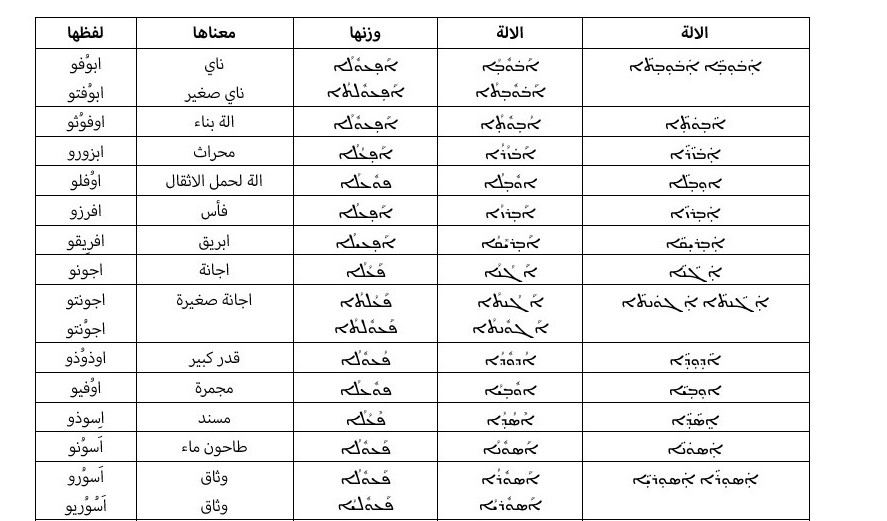Derivation of the name of the instrument in the Syriac language from new meters Eugene Manna's Dictionary as an example
DOI:
https://doi.org/10.21271/zjhs.27.s6.5Keywords:
God, gene Manna's DictionaryAbstract
The study of the Semitic languages, which are the languages of the Semitic peoples, which have made (Mesopotamia, the Levant and the Arabian Peninsula) the best way to know the ancient and authentic civilization, because language is one of the signs of civilization and is evidence of the existence of civilization and one of its components. Huge products of literature and manuscripts have been written in Syriac. And this is what attracted us to study this subject to stand on the linguistic methods contained in comparison with other Semitic languages, and to reveal their relationship and overlap.
We have chosen the subject of the name of the instrument for this study, although it has not been emphasized by linguists in the past, based on the industrial and technological revolution of this study, and as the new premise of the linguistic construction and continuous use of it, and the interest of this subject by linguists in the present.
We began with the introduction and prepared our study of the meaning of the derivation and its types and the views of the modernists. We have studied the name of the machine in the Semitic languages (Arabic, and Syriac), indicating the weights that come with the examples, in addition to writing the weights and examples in the letter of each language. The words have been translated into Arabic languages for ease of reading by others.
References
القران الكريم.
-أبن جني، أبو الفتح عثمان، تحقيق محمد على النجار، بغداد 1990.
-ابن فارس، أحمد، مقاييس اللغة، ج3، القاهرة 1948.
-ابن قتيبة، ابو محمد عبد الله، ادب الكاتب، تحقيق الشيخ محمد علي محي الدين، مصر 1963.
-أبن يعيش، موفق الدين، شرح المفصل، بيروت 1975.
-ابن منور،ابوالفضل جمال الدين محمدبن مكرم، لسان العرب، بيروت 1956.
-الاثري، محمد بهجت، مجلة المجمع العلمي العراقي، المجلد العاشر، بغداد 1962.
-الاثري، محمد بهجت، نظرات فاحصة في قواعد رسم الكتابة العربية وظوابط اللغة العربية، بغداد 1990.
-اقليمس، يوسف داود، اللمعة الشهية في نحو اللغة السريانية، الموصل 1896.
-أمين، حسن عبد الله، الاشتقاق، القاهرة 1956.
-ترزي، فؤاد حنا، الاشتقاق بيروت 1968.
-ثعالب، ابو العباس احمد، مجالس ثعلب، شرح وتعليق عبد السلام محمد، ج2 مصر 1967.
-الجادر، عادل هامل، اللغة السريانية قواعد وتطبيق، بغداد 1991.
-حسن، عباس، النحو الوافي، ج3، القاهرة، 1972.
-حطاب، أمين فعيل، قواعد اللغة المندائية، مركز البحوث والدراسات المندائية، بغداد، 2002.
-الحملاوي،احمد، شذى العرف في فن الصرف،القاهرة1972.
-الخوري، بولس، اللغة الآرامية السريانية (صرف ونحو) بيروت 1962.
-الرماني، أبو حسن علي، الحدود في النحو، تحقيق مصطفى جواد، ويوسف يعقوب، بغداد 1969.
-الزبيدي، محمد مرتضى، تاج العروس، مصر 1885.
-السامرائي، إبراهيم، فقه اللغة المقارن، بيروت 1980.
-السامرائي، فاضل، معاني الابنية في العربية، بغداد 1981.
-سيبويه، الكتاب، تحقيق وشرح عبد السلام محمد هارون، ج4، بيروت 1975.
-السيوطي، المزهر في علوم اللغة وأنواعها، شرح وتعليق، محمد جاد المولى ومحمد أبو الفضل وعلي محمد، بيروت 1987.
-العكبري، مسائل خلافية في النحو، تحقيق محمد خير، حلب 1975.
-العناني، علي، وآخرون، الأساس في الأمم السامية ولغاتها وقواعد اللغة العبرية وآدابها، القاهرة 1935.
-غبريال، فولوس، واكميل افرام البستاني، اللغة السريانية، الادب والنحو، ج2 بيروت 1966.
-الغلاييني، الشيخ مصطفى، جامع الدروس العربية، ج1، بيروت 1980.
-القرداحي، جبريل، كتاب المناهج في النحو والمعاني عند السريان، بغداد1906.
-المبارك، محمد، فقه اللغة والخصائص العربية، بيروت 1970.
-مصطفى ابراهيم، مجلة مجمع اللغة العربية، ج10، القاهرة 1958.
-معلوف، لويس، المنجد في اللغة، بيروت 1956.
-النحاس، مصطفى، مدخل إلى دراسة الصرف العربي، مصر1985.
-وهبة، مجدي، وكامل المهندس، معجم المصطلحات العربية في اللغة والأدب، بيروت 1979.
-ألبير أبونا: أدب اللغة الآرامية، دار التربية، بيروت 1970.
-منا، يعقوب اوجين، قاموس سرياني – عربي مع ملحق للمطران روفائيل بيداويد أعاد كتابته وتدقيقه الرّاهب السريانيّ زيتون صومي 2015.

Downloads
Published
Issue
Section
License
Copyright (c) 2023 Anmar Abduljabbar Jasim

This work is licensed under a Creative Commons Attribution 4.0 International License.









